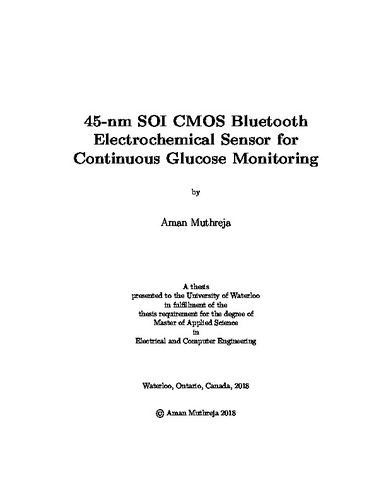| dc.description.abstract | Due to increasing rates of diabetes, non-invasive glucose monitoring systems will become critical to improving health outcomes for an increasing patient population. Bluetooth integration for such a system has been previously unattainable due to the prohibitive energy consumption. However, enabling Bluetooth allows for widespread adoption due to the ubiquity of Bluetooth-enabled mobile devices. The objective of this thesis is to demonstrate the feasibility of a Bluetooth-based energy-harvesting glucose sensor for contact-lens integration using 45~nm silicon-on-insulator (SOI) complementary metal-oxide-semiconductor (CMOS) technology.
The proposed glucose monitoring system includes a Bluetooth transmitter implemented as a two-point closed loop PLL modulator, a sensor potentiostat, and a 1st-order incremental delta-sigma analog-to-digital converter (IADC). This work details the complete system design including derivation of top-level specifications such as glucose sensing range, Bluetooth protocol timing, energy consumption, and circuit specifications such as carrier frequency range, output power, phase-noise performance, stability, resolution, signal-to-noise ratio, and power consumption. Three test chips were designed to prototype the system, and two of these were experimentally verified. Chip 1 includes a partial implementation of a phase-locked-loop (PLL) which includes a voltage-controlled-oscillator (VCO), frequency divider, and phase-frequency detector (PFD). Chip 2 includes the design of the sensor potentiostat and IADC. Finally, Chip 3 combines the circuitry of Chip 1 and Chip 2, along with a charge-pump, loop-filter and power amplifier to complete the system.
Chip 1 DC power consumption was measured to be 204.8~$\mu$W, while oscillating at 2.441 GHz with an output power $P_{out}$ of -35.8 dBm, phase noise at 1 MHz offset $L(1\text{ MHz})$ of -108.5 dBc/Hz, and an oscillator figure of merit (FOM) of 183.44dB. Chip 2 achieves a total DC power consumption of 5.75~$\mu$W. The system has a dynamic range of 0.15~nA -- 100~nA at 10-bit resolution. The integral non-linearity (INL) and differential non-linearity (DNL) of the IADC were measured to be -6~LSB/$\pm$0.3~LSB respectively with a conversion time of 65.56~ms. This work achieves the best duty-cycled DC power consumption compared to similar glucose monitoring systems, while providing sufficient performance and range using Bluetooth. | en |

